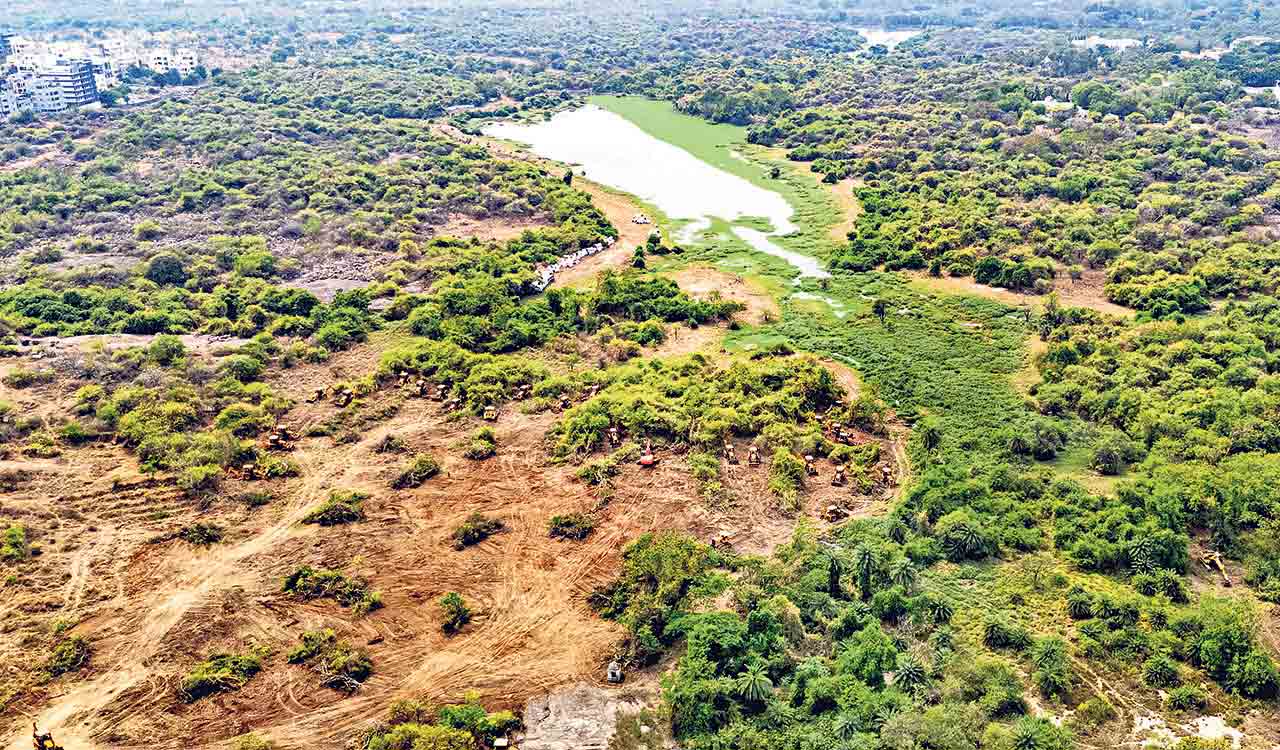Such a move could radically alter the legal and ecological landscape of Hyderabad’s most hotly contested land
Published Date – 9 April 2025, 08:21 PM

File Photo
Hyderabad: As members of the Supreme Court-appointed Central Empowered Committee (CEC) prepare to visit Kancha Gachibowli on Thursday, a critical question looms large.
Is this 400-acre green patch a ‘forest’ in the eyes of the law? If yes, it could radically alter the legal and ecological landscape of Hyderabad’s current most hotly contested land.
The CEC, comprising Chandraprakash Goyal (former IG of Forests) and Sunil Limaye (former Chief Wildlife Warden, Maharashtra), are scheduled to visit the site on Thursday and hold meetings with the State officials. Their report, due by April 16, will be central to the Supreme Court’s final decision on the ongoing deforestation and development activities at the site.
What is a forest — legally and scientifically?
In India, the definition of ‘forest’ is not confined to officially notified reserved or protected forests. As per the Supreme Court’s judgment in the TN Godavarman Thirumulpad vs union of India (1996) among others, reaffirmed multiple times since — any land recorded as forest in any government record, or appearing to be forest by characteristics, irrespective of ownership, is to be treated as deemed forest and falls under the purview of the Forest (Conservation) Act, 1980.
Separately, the Government of India is a signatory of the 9-Kyoto Protocol at Conference of Parties (CoP)-19. Accordingly, the Ministry of Environment and Forests and Forest Survey of India’s India State of Forest Report (ISFR) report, forest cover is defined as “any land larger than 1 hectare with tree canopy density above 10 per cent and tree height of 2 m and above, irrespective of ownership or legal status.”
By both standards, Kancha Gachibowli qualifies. The land harbours dense greenery, home to over 72 tree species, including rare ones such as Marking Nut Tree (Semecarpus anacardium) and over 230 species of birds, 32 reptiles, 13 amphibians and mammals, including peacocks and spotted deer, and the Murricia hyderabadensis, one of the world’s rarest spiders.
Why this matters now?
The Supreme Court’s order on April 3 has already halted all activity in the area. But if the CEC report confirms that Kancha Gachibowli meets the criteria of a deemed forest, the entire land would come under the Forest (Conservation) Act, 1980. Any non-forestry use of this land would require prior approval from the union Ministry of Environment, Forest and Climate Change. Further, violations could attract criminal and civil liabilities on the implementing agencies.
What is at stake for the Congress government?
The TGIIC had mortgaged the land to raise Rs 10,000 crore through off-budget borrowing, intending to auction it for Rs 30,000 crore. If declared a forest, the land can no longer be auctioned — triggering a fiscal crisis for the Congress government. However, it would come as a welcoming relief for the students of the University of Hyderabad (UoH), environmentalists and also the people of Hyderabad. The Supreme Court’s final ruling, expected after April 16, may well redefine the future of urban ecology in Telangana.
Violation of Environmental and Wildlife Laws
In its hurry to clear the green cover, the Congress government appears to have violated multiple laws. Under the Telangana Forest Act, 1967, tree felling without permission can attract imprisonment (three months to one year) and fines.
The Kancha Gachibowli land is an abode for 27 species, including birds and reptiles, under Schedule-1 of the Wildlife Protection Act (WPA), 1972, that receive the highest level of legal protection in India. Any violation of the law, including hunting and habitat destruction, would attract imprisonment of three-seven years and a fine of Rs 25,000-Rs 50,000 or both.
Shockingly, the tree felling was carried out by the Congress government in a haste, in utter violation of the GO 23 (2017). The orders issued by the then K Chandrashekhar Rao government mandates prior tree enumeration and permission under TS-iPASS and WALTA.
According to the GO, those intending to fell trees on government or private land for establishing new industries or to convert the land use for industrial purposes, must apply under TS-iPASS for necessary approvals.
The Principal Chief Conservator of Forests and Head of Forest Force will get the trees enumerated falling in the Industrial Local Authority (ILA) based on the report received from the Industry department (TGIIC). If the proposed area for felling of trees is more than 2 hectares, it will be categorised as High Risk Category.
Forest officials should carry out the test check of 10 per cent of the trees in the Enumeration List. Sources in the Forest Department confirmed that neither did the TGIIC seek such permission nor did the Forest Department conduct any enumeration of the trees in the said land parcel.







